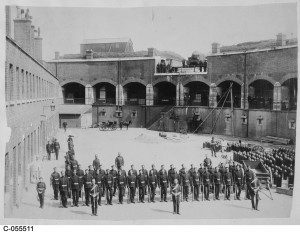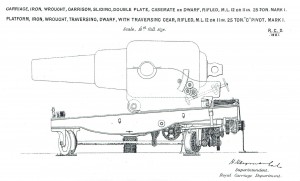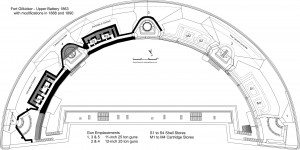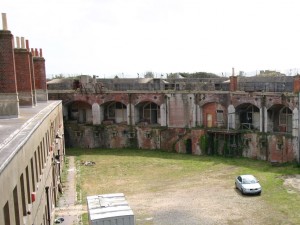
This amazing photograph of the interior of Fort Gilkicker circa 1890 shows the upper battery at Fort Gilkicker with a heavy 12-inch RML of 25 tons Mk1 in emplacement no.4 on a C pivot dwarf platform. This is a recent discovery in the Library and Archives of Canada (E. Gary Carrol collection, image: C-055511) and it has revealed a unique view of Fort Gilkicker showing the Royal Garrison Artillery and Volunteers on parade. This would be usual for a Volunteer practice camp at the fort with the volunteers being supervised at their gun drill by the regulars. In time of need when it was likely that the fort would be brought into action the regular garrison artillery in the fort would be supplemented by the Volunteer artillerymen. The Volunteers were essential to increase the numbers of trained men to man the guns. Volunteers trained on the guns during Summer camps under the direction of the regular garrison gunners. For the rest of the year the guns were put into care and maintenance.

Gilkicker was often used for Militia and Volunteer training and was occupied by three batteries from the Hampshire Artillery Militia during their 28 days embodiment in 1871. Again on June 19th 1885 No.5 Battery moved into Fort Gilkicker and was inspected by the Officer Commanding Royal Artillery Gosport District on July 6th. In 1885 the 2nd Middlesex drilled on the 9, 10, 11 and 12-inch RMLs at Fort Gilkicker. In 1888 it was the turn of the 5th Lancashire Volunteers to drill at Gilkicker.

The Hants Volunteers were back at Gilkicker in January and May 1891 and June 1897 for training. They drilled on the guns at Gilkicker on a regular basis, using the 9 and 10-inch RMLs in the lower casemates after the upper battery was disarmed circa 1891. The 1st Hants Volunteers, based in Southampton travelled regularly by train to Fort Brockhurst Station where they alighted for quartering in Fort Rowner. They would march to Fort Gilkicker to carry out their day’s training on its guns. In 1890 it was reported by Colonel Bance of the 1st Hants Artillery Volunteers that they were were:
...in future to be mobilised at Gilkicker, the entrance to Portsmouth Harbour, and also for the adjacent lines of fortifications, and he should be sending them down in detachments on Saturday afternoons, by train running at convenient time, to spend a brief period there, which would be enjoyable well as instructive to them, and then bring them back refreshed and invigorated, and better in every respect for the training they had undergone.
Sometimes the 1st Hants travelled by steamer from Southampton, alighting at the War Department pier at Stokes Bay and then marching the short distance to the fort.
Garrison guns were to be fired at Station Practice three times consecutively every other year to train the gun crews and to ensure that the guns were in perfect working order. The three rounds were to be fired on the same day from the whole of the guns in the fort, or from as many complete gun groups as was possible. In the photograph shells can be seen standing on the parade prior to being moved to the shell stores before firing can commence. These were perfectly safe, wherever stored, until they were fused at the time of firing. Station practice was to be carried out annually from half the forts in the district. This practice was to ensure not only instruction but also to test thoroughly the working condition of the mountings and gears as well as the fitments and accessories of the fort, the supply of ammunition and the means for fighting the guns generally.
Interesting detail shown in the photograph includes two four wheeled shell barrows, one of which is in use as a child’s pram! Gosport’s own Major Cunningham, who lived in Bury House, and who was an officer in the local volunteers, trialled much of his inventions for traversing and firing heavy guns at Fort Gilkicker. Some of these were adopted for use in forts and on board ships. One piece of equipment tested at Gilkicker was a new shell bearer used to move the shells from the basement stores to the guns. A report at the time noted that the shell passage at Gilkicker was too narrow to allow two barrows to pass. These unusual shell barrows may be the solution to the problem. The sheer legs and nearby winch (crab) seem to be in use to lift stores, or possibly the shells, to the gun casemates, which were armed with 9-inch RMLs and 10-inch RMLs. This may have been part of the usual Gyn drill undertaken by the Volunteers during training.
An example of a training event by the 2nd Middlesex Volunteer Artillery at Fort Gilkicker was reported in the Volunteer Service Gazette May 1st 1886:
On Good Friday, guard was mounted at 8 a.m., and at 10.30 the brigade paraded with the Royal Artillery of the Garrison, and marched, under command of Colonel Hume, R.A., the commandant of the Fort, to the Garrison Church, near Fort Rowner, for divine service. After dinner, the brigade assembled in fatigue order at 1.30 p.m., and, headed by the band, marched to Fort Gilkicker, on the Solent, for drill with the 9, 10, 11, and 12-inch R.M.L. guns, returning to quarters at 5 p.m. At 6.15 p.m. the brigade turned out in drill order for battalion drill under the Adjutant, – Major Lowrie, which finished the work of the day.
On Saturday, after an early breakfast, parade was formed in fatigue order at 8.30 a.m., every man carrying his haversack and water-bottle, with a day’s rations, and the brigade again marched to Fort Gilkicker for practice. The military authorities had arranged that the annual practice of that station should be entrusted on this occasion to the 2nd Middlesex Brigade, a mark of confidence which was much appreciated by the Volunteers. The casemates had been cleared of the soldiers’ barrack furniture, and all glass and bulkheads removed. Practice was carried on with Palliser shot and shell from the 9, 10, 11, and 12-inch guns, under the direction of Major Arbuckle, R.A. until 4 p.m. Amongst the Royal Artillery officers present were Colonel Hume, Colonel Stirling, Colonel Finch, commanding the Auxiliary Artillery of the Home District, who had come down especially to inspect the Brigade, which forms part of his command.
